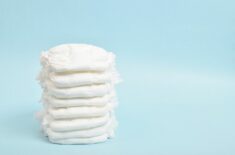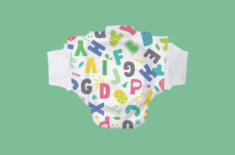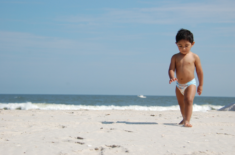Overview
Your baby’s first year might seem like a whirl of breastfeeding (or bottle-feeding) and diaper changes. You might ask, how many diapers does your little one really need in a year? Should you stock up so you never run out, especially in the middle of the night?
Amazingly, the average baby uses around 2,500 to 3,000 diapers per year. (1)
Situations can vary, and the exact number will be different per child. However, it is estimated that the average diaper usage is 6,000 to 8,000 per child before they’re potty trained. (1)
They can even go through as many as 10 to 12 diapers daily. (1)
No wonder diapers are also popular as baby shower gifts.
The good news is that you can buy diapers online and pay for a diaper subscription, so you never have to worry about running out of stock at any time of the month.
Below, we’ll answer questions on what size diapers to buy the least or the most, how to know when to size up, and whether buying by box or bag is more practical.
Fast Facts: How Many Diapers Are Used Annually?
As many as 95% of parents in the US only use disposable diapers. The US is estimated to generate over 3.5 million tons of waste from around 20 billion pieces of used diapers in landfills annually. (1)(2)
Unsurprisingly, the diaper industry is worth $71 billion a year. Costs vary, depending on many factors and your personal preferences, though you can expect to spend around $1,000 to $2,500 on diapers in your baby’s first year. (1)
Health Tip: Keeping Your Baby’s Bottom Clean & Comfortable
1. Frequency Of Diaper Change
Babies can go through 10-12 diapers daily, with diaper changes every 2-2.5 hours. But the actual varies based on age, diaper size, and bowel movements. (1)
Ways to tell they’re ready for diaper change:
- You can see the line (for diapers with a wetness indicator)
- Check every 1-2 hours if the diaper is wet
Should You Change Diapers As Soon As Your Baby Pees Or Poops?
Wet diapers need to be changed as soon as possible, especially if your baby has pooped. Prolonged exposure to wet and/or soiled diapers can lead to diaper rash. (3)
It’s a type of skin inflammation within the diaper area characterized by patches of bright red skin. In serious cases, the baby’s skin might peel in some affected sections. (3)
Some tips to avoid diaper rash: (3)
- Use diaper cream.
- Choose absorbent diapers that lock moisture away from your little one’s skin.
- Change diapers often, and don’t wait until they’re filled.
- Always change diapers when your baby poops.
- Wash hands before and after each diaper change.
Surprisingly, a 2017 Dermatology Reports study showed breast milk can help alleviate diaper rash. (4)
Regularly changing your baby’s diapers also helps prevent UTI (urinary tract infection).
2. Consider Nighttime Diapers For Older Babies
Nighttime diapers are designed to be more absorbent than regular diapers. They’re usually advertised to work for 12+ hours. They’re ideal when your baby starts sleeping through the night at around 6+ months of age.
3. When To Size Up
Tight-fitting diapers can increase your baby’s risks of diaper rash because they may lead to rubbing and chafing on their soft, sensitive skin. (5)
Here are some common situations that signal it might be time to size up:
- Your baby is near or over the diaper’s weight limit.
- Red marks or indentations on baby’s skin, particularly along the diaper’s edges and elastic parts.
- Their diapers are constantly leaking or getting full faster.
- You can’t fit two fingers between your baby’s tummy and the diaper’s waistband.
Because diapers usually have overlapping age or size recommendations, we suggest sizing up when your baby reaches the overlap. For example, go for Size 3 (16 – 28 lbs) when your baby starts weighing 16 lbs, even if they still fit a Size 2 (12 – 18 lbs).
However, if you still have diaper stocks for the smaller size, you can continue using them. It’s important, however, to make sure the smaller diaper size isn’t too tight on your baby.
4. Breastmilk Vs. Baby Formula
Breastfed babies might have more frequent bowel movements than those given infant formula. (6)
5. Important Note For New Parents: Babies’ Growth Rates & Needs Can Vary
Babies grow at varying rates. Your baby might need less or more diapers than their siblings or other infants and toddlers.
Consider this when stocking up on diapers, especially if you’re getting a subscription.
The number of diapers can also vary depending on certain situations. For example, some first-time parents may change baby diapers more frequently, particularly during the first few days.

On community forums or social media sites, other parents shared different numbers: (7)

Disposable Diaper Calculator & Guide
Diaper Supplies Your Baby Needs Per Day
Newborn Diaper Use Per Day
Expect around 6-10 wet diapers and 3-4 soiled diapers (with poop) per day for newborns in their first month of life. That’s because their bladder and bowels are still tiny and continuing to develop. (6)
Newborns also soil their diapers more frequently as they pass meconium, a dark, greenish, and tarry substance considered as “first stool or poop.” (6)
Some babies might not pass a lot of urine during their first few days of life. But you can expect the number of wet diaper changes (not counting soiled diapers) to increase with each passing day: (8)
- Approximately two wet diapers by day 2
- Around three or more wet diapers by days 3 and 4
- Typically, six or more wet diapers by day 5
You can expect around 3-4 soiled diaper changes by day 4. This can continue for about a month. (6)(8)
Other babies might also poop around 1-2 times a day during their first month. Some might have increased bowel movements 5-10 times after the first week, especially if they’re breastfed. (9)(10)
We recommend preparing around 8-10 diapers for your baby’s first month. (1)
How Many Diapers Per Day Do Babies Need At 1+ Months?
Average diaper changes at 1+ months: (10)
- 1+ months old: Around 10-12 diapers
- 2-4 months old: Around 10 diapers per day (about 1-2 soiled diapers)
How Many Diapers Per Day Do Babies Need At 6+ Months?
Average diaper changes at 6+ months: (10)
- Up to 8 months old: Around 9 diapers per day
- 9-12 months old: Around 7 diapers per day
Diaper Supplies Your Baby Needs Per Month
Newborn Diaper Use Per Month
At 8-10 diapers x 30 days = 240 to 300 diapers per month (1)
Other Estimated Diaper Usage Per Month
Based on the daily calculations above: (10)
- 1+ months old: 10-12 diapers x 30 days = 300 to 360 diapers per month
- 2-4 months old: 10 diapers x 30 days = 300 diapers per month
- Up to 8 months old: 9 diapers x 30 days = 270 diapers per month
- 9-12 months old: 7 diapers x 30 days = 210 diapers per month
How Many Diapers Is A Year’s Supply (By Age)?
Estimated Total Number Of Diapers Your Baby Needs In Their First Year?
Newborn Babies To 1 Month Old
At 8-10 diapers x 30 days x 12 months = 2,880 to 3,600 diapers per year (1)
1-6 Months Of Age
- 1+ months old: 10-12 diapers x 30 days x 12 months = 3,600 to 4,320 diapers per year
- 2-4 months old: 10 diapers x 30 days x 12 months = 3,600 diapers per year
6+ To 12 Months Old
- Up to 8 months old: 9 diapers x 30 days x 12 months = 3,240 diapers per year
- 9-12 months old: 7 diapers x 30 days x 12 months = 2,520 diapers per year
Diapers For Toddler Age
How Many Diapers Do Toddlers Use At 1+ Years Old?
- 1+ years old: 5-7 diapers per day x 30 days x 12 months = 1,880 to 2,520 diapers per year
How Many Diapers Do Toddlers Use At 2+ Years Old?
- 2+ months old: 4-5 diapers per day x 30 days x 12 months = 1,440 to 1,880 diapers per year
How Many Years Do Babies Need Diapers?
The average potty training age in the US starts at around 2-3 years old, with most kids likely to be fully bladder and bowel trained by age 4. (11)
However, this can vary among children.
American economist and Parent Data CEO Emily Oster explains that starting “later” or at around 25-30 months may help with potty training success rather than doing it too early. For example, kids who started potty training at 3-3.5 years learned at around 9 days, while those who started under 18 months took about 12 weeks. (19)
So, your baby will likely need diapers for 2-3 years, or a maximum of four.
Total Number Of Diapers The Average Baby Might Use In A Lifetime
- Around 6,000 to 8,000 per child before they’re potty trained (1)
Tips For Building Disposable Diaper Stockpile
Determine If You Need To Stock Up On Diapers
- Convenience and needs
- Depends on your available storage space
- Saving some money by buying a lot of diapers (bulk)
Choosing The Right Diapers Before Buying In Bulk
Our Recommendations: Reducing Risks Of Diaper Rash & Protecting Your Baby’s Skin
Certain chemicals in diapers can irritate your baby’s sensitive skin. We recommend the following non-toxic brands:
- The Honest Company
- Hello Bello Diapers
- Coterie
- Dyper
- Thrive Market
- TinkyPoo
Also, read our recommendations for the best pull-ups (for older toddlers).
Pampers Vs. Huggies: Which One To Buy?
Pampers and Huggies are two of the major diaper brands in the US and worldwide. Different parents prefer one over the other and have varied experiences with blowouts, absorbency, allergic reactions, etc.
Here are some comments from parents on Reddit: (12)

Here are some of our reviews of products from these diaper brands:
- Huggies Snug And Dry Vs. Little Snugglers
- Pampers Baby Dry Vs. Swaddlers
- Pampers Swaddlers Vs. Cruisers
Get Diapers In Different Sizes
Diaper Sizes Are Based On Your Baby’s Weight
Typical diaper sizes used by major brands such as Pampers:
- Preemie or Size P1 (6 lbs & under)
- Newborn or Size 0 (10 lbs & under)
- Size 1 (8 – 14 lbs)
- Size 2 (12 – 18 lbs)
- Size 3 (16 – 28 lbs)
- Size 4 (22 – 37 lbs)
- Size 5 (27 – 35 lbs)
- Size 6 (35+ lbs)
- Size 7 (41+ lbs)
Pro Tip: Sizes Can Vary Among Brands
Other brands might use a different weight range.
Stocking Up On Diapers Depending On Usage
How Long Do Babies Use Newborn Diapers?
- Around 2 weeks
Is It Better To Buy Size 0 Or 1 For Newborns?
- Size 0
The average birth weight in the US is 7 lbs. (13)
Size 0 (Newborn) diapers usually have a cut-out section for your baby’s umbilical cord. So, they’re still preferable for newborns over the standard Size 1 diaper. (14)
What Diaper Size Should A 9-lb Newborn Use?
- Size 1
What Diaper Size Do Babies Use The Longest?
- Varies among babies but might be Size 3 or 4 because babies’ growth curves are usually not as steep beginning 6+ months (around 22 lbs for boys or 21 lbs for girls) (see charts below) (15)(16)


Get More Diapers In Sizes 1-3
- Babies need Sizes 1-2 only during the first few months but require more diaper changes
- Babies are more likely to need Size 3 for a longer time
Varying Needs For Baby Girls Vs. Boys
Some diaper brands offer gender-specific diapers. These diapers are designed with more absorbent sections where boys or girls pee the most.
Examples include:
- Huggies Pull-Ups Boys’ Training Pants (boys)
- Pampers Ninjamas Nighttime Bedwetting Underwear (girls)
- Up & Up Boys’ Training Pants
- Bambo Dreamy Potty Training Night Pants for Girls
Diaper Hacks For Baby Boys
- Cover your baby’s penis with wipes to avoid getting sprayed with pee while changing their diaper
- Gently lift your baby’s testicles to wipe poop that might have squished under them
Start Small But Stockpile Slow & Steady
- Consider stockpiling slowly (one pack or box per month)
- Start with the smaller sizes
When Do You Start Stocking Up Diapers?
- Around the third trimester of pregnancy
- Other moms suggest waiting until after you give birth so you know which are the right ones to suit your baby

FAQs
What If My Baby’s Diaper Count Is Actually Too Low?
A low diaper count (such as fewer than six wet diapers daily for newborns) might indicate dehydration. Contact your healthcare provider for guidance. (6)
What Happens If My Baby Needs Too Many Diapers?
Your baby might have diarrhea or loose bowel movement, especially if they have watery stool and feel fussy. (18)
Do Diapers Ever Expire & What Should I Check Before Using The Stored Ones?
Diapers don’t usually expire (but check the packaging to be sure). Also, check the following before using stored diapers:
- Signs of discoloration and mold
- Less absorbent than before
- Reduced elasticity and adhesion
Smart Saving Tips
- Save money on boxes of diapers (buying in bulk)
- Consider diapers for your baby registry
- Save money with a diaper subscription
- Spread the cost & save money with coupons & discount hacks
- Special club membership discounts
- Cash-back shopping apps
- Save money on cheap diapers
- Watch out for store sales
- Free diapers from your community center, diaper banks, or samples from your pediatrician or hospital
- Consider reusable cloth diapers
For Dirty Diapers
Recent Baby Product Recalls & Safety Warnings
Stay informed with the latest news by signing up for our regular Motherhood Community recall alerts so you never miss an important recall.
Check these comprehensive lists of product recalls by category:
- Crib recalls (up to 2023)
- Stroller recalls (2020 to 2023)
- Recalled toys list (2020 to 2023)
- Baby formula recall (2001 to 2023)
- Baby food recall (2015 to 2023)
- Pacifier recall (2019 to 2022)
- Baby wipes recall (2014 to 2022)
References
(1) https://www.crossrivertherapy.com/research/diaper-facts-statistics
(2) https://www.sciencedirect.com/science/article/abs/pii/S0957582018303860
(3) https://www.pediatricspec.com/storage/app/media/resources/DiaperRash.pdf
(4) https://pubmed.ncbi.nlm.nih.gov/28626535/
(5) https://www.mayoclinic.org/diseases-conditions/diaper-rash/symptoms-causes/syc-20371636
(6) https://nurturenourishservices.com/learn/how-many-diapers-a-day
(7) https://www.reddit.com/r/pregnant/comments/ksftvn/approximately_how_many_diapers_do_you_use_a/
(8) https://llli.org/breastfeeding-info/is-baby-getting-enough/
(9) https://www.healthlinkbc.ca/pregnancy-parenting/parenting-babies-0-12-months/new-parents/babys-daily-needs-what-expect
(10) https://www.momswhothink.com/how-many-diapers-does-a-baby-use-by-age/
(11) https://www.healthychildren.org/English/ages-stages/toddler/toilet-training/Pages/the-right-age-to-toilet-train.aspx
(12) https://www.reddit.com/r/Parenting/comments/s6yiuv/pampers_vs_huggies_which_do_you_prefer/
(13) https://www.urmc.rochester.edu/encyclopedia/content.aspx
(14) https://www.goodhousekeeping.com/life/parenting/a32960612/diaper-sizes-guide/
(15) https://www.cdc.gov/growthcharts/data/who/grchrt_boys_24lw_100611.pdf
(16) https://www.cdc.gov/growthcharts/data/who/grchrt_girls_24lw_9210.pdf
(17) https://www.reddit.com/r/Mommit/comments/164lgqm/should_i_be_stocking_up_on_diapers_6_months/
(18) https://www.seattlechildrens.org/conditions/a-z/diarrhea-0-12-months/
(19) https://parentdata.org/potty-training-best-advice/












